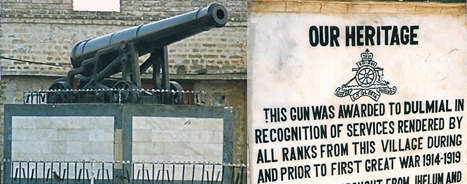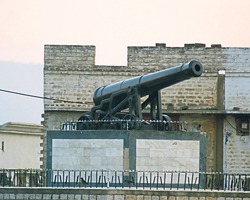Remembering the Soldiers of the First World War, 100 years on

 A nineteenth century cannon sits at the centre of a Pakistani village.
A nineteenth century cannon sits at the centre of a Pakistani village.
Dulmial is a village approximately 100 miles south of Islamabad, in the Salt Range region. A century ago, the area was part of British India, which meant that its inhabitants were drawn into the Great War on the side of the Allies. A settlement steeped in military history, Dulmial sent 460 of its men to fight in the British Army, including both of Dr Malik’s great grandfathers. The largest single participation of any village in Asia. Nine gave their lives.
 In recognition of the significant military service and sacrifice, in 1925 the British Government offered Dulmial an award of their choosing. The man in charge of choosing was Captain Ghulam Mohammad Malik, the highest ranking and most decorated soldier of the village. The Captain was a man of great experience, having commenced his military life in the Derajet Mountain Battery and participated in Lord Robert’s famous march from Kabul to Kandahar in 1880.
In recognition of the significant military service and sacrifice, in 1925 the British Government offered Dulmial an award of their choosing. The man in charge of choosing was Captain Ghulam Mohammad Malik, the highest ranking and most decorated soldier of the village. The Captain was a man of great experience, having commenced his military life in the Derajet Mountain Battery and participated in Lord Robert’s famous march from Kabul to Kandahar in 1880.
The British agreed to this selection and provided Dulmial with a twelve pounder. The cannon itself was made at Carron ironworks, in Falkirk, Scotland in 1816. The stand was built in Cossipore Gun Foundry, India under the leadership of Captain A. Broome, in 1847. The gun was first collected from the First Punjab Regimental Centre in Jhelum, from where it was carried by train to Chakwal. There the gun was dismounted and loaded in a cart to be pulled by three pairs of oxen for the remaining 28 kms.
Safely in Dulmial, the gun was place at the centre of the village and a photograph taken with the local commissioned officers. It remains there today, a reminder of the contribution that Dulmial made in the First World War.
By Dr Irfan Malik and Michael Noble

































